 " Alright guys, just awhile more... Ok, now lift your net up!"
" Alright guys, just awhile more... Ok, now lift your net up!"These were the words of one of the LSM1103 TA, Karenne Tun, to her groups right before we set out towards the sea for our dive. This time, Lynn and Min Sheng, both PADI DMT, accompanied me for this dive. With many LSM1103 students and TAs staring at us.
For experienced divers, the best time to dive is during the slack tide when the movement of water is minimal. However, due to the desire to synchronise with the groups having the field trip so as to obtain a correlation between their 'catch' and our sightings, we resorted to dive during the low tide. On top of this, it was spring tide today!
Nevertheless, we dived anyway. First, because of of the desire to find out what lies beneath during this time. And secondly, to understand the condition of diving during this 'inadvisable' period.
So the dive began at depth of about 2m. The visibility was so bad that I could not see the beam of the dive torch. In other words, there was no visibility. As such, we could see NOTHING. However, as I was attempting to navigate, my hand got hold of a empty bivalve shell. Due to the lack of visibility, we decided to ascent and reluctantly abort the dive. We were only 10mins underwater. Also, the spring tide current swept us about 200m towards the west.
Below is the video clip to illustrate the extremely bad visibility of the waters at the depth of 1.1m.
On the surface, I managed to have a look of the shell and discovered that it was that of a blood cockle (Anadara spp.) which is related to clams which mostly populate the inter- and shallow sub-tidal depth range. The pigments of the live cockle is contains haemoglobin which is similar to that of human blood, which is most probably the origin of its common name.
 Upon approaching the beach, we encountered patch of marine clay at the bottom of the shallow waters. As such, Lynn and I had difficulty moving because our legs sinked into the 'soft ground' after every steps. Eventually, we reached the beach safely though.
Upon approaching the beach, we encountered patch of marine clay at the bottom of the shallow waters. As such, Lynn and I had difficulty moving because our legs sinked into the 'soft ground' after every steps. Eventually, we reached the beach safely though.On land, we went to look at the tanks which contain the 'catch of the day' from the LSM1103 groups. It was full of ANIMALS!! The nets which we saw before the dive do indeed had a catch!! Some species include moon crab (Matula lanaris), Copper Banded Butterfly Fish (Chelmon rostratus), Leather jacket (Monacanthus sp.), Puffer fish (Arothron sp.) etc.
 Instead of taking pictures outside the tanks, I decided to test the water resistant function of the camera by submerging the naked camera in the tank while taking pictures. However, most of the pics are overexposed though.
Instead of taking pictures outside the tanks, I decided to test the water resistant function of the camera by submerging the naked camera in the tank while taking pictures. However, most of the pics are overexposed though.To sum up, these are the following lessons learnt today although our objective was not fulfilled:
1. Life is present in Changi beach (as revealed from the catch), though while underwater we may not see them underwater, including the sessile.
2. Spring and low tide is indeed not a good time to dive.
3. New informations for future dive in Changi (will be revealed later)
Therefore in ending, I would like to quote from the comment of the TA Jeff:
"Bro, you come at the wrong time la!"
Keywords:
Slack tide: time during which no appreciable tidal current is flowing in a body of water.
neap tide: times with minimum fluctuation of tide, happens when sun and moon, relative to earth, are at right angles to each other.
Spring tide: times with maximum fluctuation of tide, happens when the sun, moon and earth are in alignment.
References:
Manuel C. Molles Jr (2007). Ecology Concepts & Applications, 4th Edition. McGraw Hill. P60.
Slack tide: time during which no appreciable tidal current is flowing in a body of water.
neap tide: times with minimum fluctuation of tide, happens when sun and moon, relative to earth, are at right angles to each other.
Spring tide: times with maximum fluctuation of tide, happens when the sun, moon and earth are in alignment.
References:
Manuel C. Molles Jr (2007). Ecology Concepts & Applications, 4th Edition. McGraw Hill. P60.
Blood Cockle. A guide to seashores in Singapore. Retrived on 26th October 2007 from
The Encyclopedia of Recreational Diving 3rd edition. PADI.
Slack water. (2007, October 24). In Wikipedia, The Free Encyclopedia. Retrieved 17:00, October 26, 2007, from
Upcoming:
Inspired by the lecture on protection, I have decided to write a short entry about the common Copper Banded Butterfly Fish (Chelmon rostratus) and how it protect itself from predation in a unique way. Watch out for this entry which will open you EYES to the "EYE" of the butterfly fish titled:
Butterfly fish and its little black dot.

1 comment:
Congrats on your 2nd dive in SG waters. How about doing a dive off Ubin? Maybe spot a Dugong ?
Post a Comment